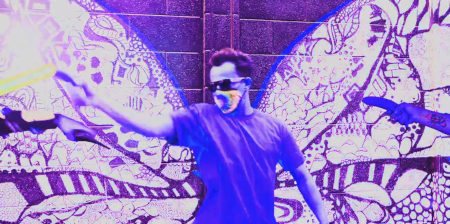366 Weird Movies may earn commissions from purchases made through product links.
DIRECTED BY: Mercedes Bryce Morgan
FEATURING: Morgan Saylor, Danilo Crovetti, Kat Foster, Myko Olivier, Keith Powell
PLOT: Millicent applies for a nanny job caring for a special needs kid with crippling allergies; unbeknownst to the parents (who are pretty screwed up themselves), Millicent is under psychiatric care, undergoing an experimental therapy where she microdoses LSD daily.

COMMENTS: Millicent, the lead character of Spoonful of Sugar, has been prescribed LSD by her psychiatrist, to be taken in microdoses. Microdosing psychedelics is an online fad taking its cue from homeopathy. It involves taking amounts of the drug too small too produce psychedelic effects on a regular schedule. When this practice is followed, the user does not hallucinate. Also, short-term tolerance to LSD builds very quickly, requiring larger doses to achieve any effects, so regular dosing should provide diminishing returns. The practice’s proponents claim that it improves their well-being and quality of life without producing a disabling intoxication, but the supposed benefits have never been studied on a meaningful scale; the evidence is overwhelmingly anecdotal. It is currently not legal to prescribe LSD.
In other words, real-life microdosing is nothing at all like the picture painted in Spoonful of Sugar: hallucinations would be virtually impossible, and no reputable psychiatrist would (or could) ever prescribe the substance. In one sense, this is a minor issue. We could suspend disbelief and head-canon Millicent’s treatment into some kind of experimental pilot program set sometime in the near future. We can posit that she hallucinates because of an underlying mental illness, possibly exacerbated by the LSD regimen (a reasonable supposition). But I think that the sloppy handling of the microdosing concept underlies the problems with the promising but ultimately unfulfilling Spoonful of Sugar. The premise sounds cool, but it just doesn’t work, at least not as executed here. But the filmmakers decide to go ahead with it anyway, trusting that the viewer will skim over the obvious flaws and focus on the vibrant hallucinations (a demonic sex scene, a crawling severed finger) and dark psychology.
If you can get involved enough in the story to make it to the end, Spoonful of Sugar concludes on a strong note, with an exciting and unexpected violent finale ending in a dark twist. Hopes of running into another psychedelic nightmare prods you to stick with it. But unfortunately, the bad mostly outweighs the good here. Morgan Saylor is asked to strike a difficult tone as the “weird girl,” required to be quietly sinister, wounded, naive, and delusional, all at the same time. It’s a tough assignment, and she has difficulty creating a believable character: her expressions and readings are awkward and forced, forcing her wardrobe and hairstyle (Red Riding Hood coat, Pippi Longstocking braids) to do the heavy lifting in constructing her childlike persona. The script, which includes creaky, clumsily ironic lines like “people aren’t always as they seem” and “women aren’t violent,” doesn’t provide a lot of support. The other main performances are fine, especially Kat Foster as the mother with issues relating to her sick child and a secret taste for masochism; Danilo Crovetti also makes a convincing kid, helped by the fact that he’s embedded in an astronaut costume for most of the picture and has very few lines. But a credible performance from Millicent is central to making this logically-challenged scenario successfully pull off the trick it wants to—and on this score, the experiment falls short.
A Spoonful of Sugar is now on DVD and available on VOD; it also streams on Shudder.
WHAT THE CRITICS SAY:






